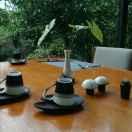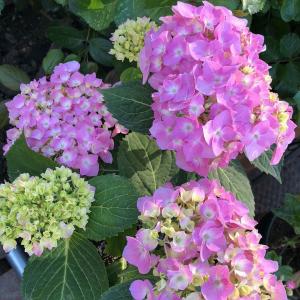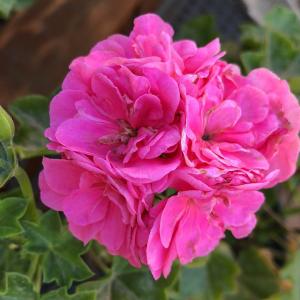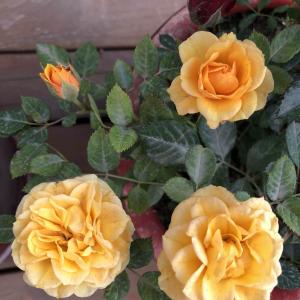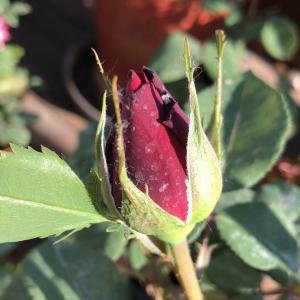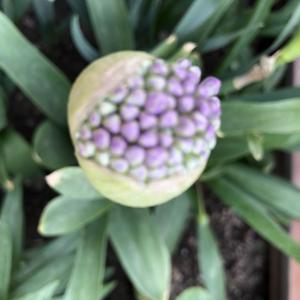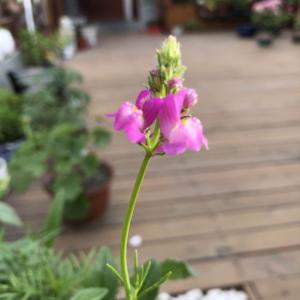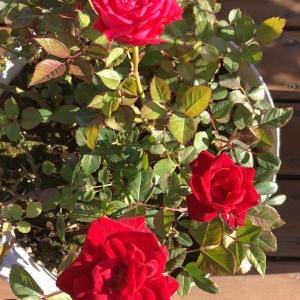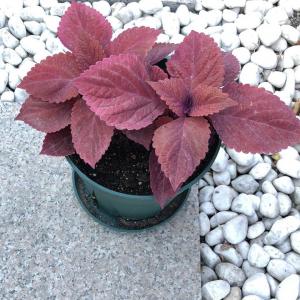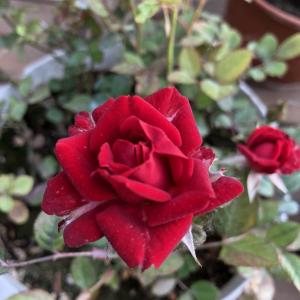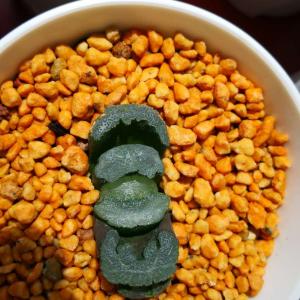文章
Miss Chen
2018年05月03日

Description: This perennial plant is 1-3' tall and unbranched or sparingly branched. The central stem is light to dark green, 4-angled, and covered with long white hairs. The opposite leaves are up to 3½" long and 1½" across. They are ovate or lanceolate-ovate in shape, serrated along their margins, and often ciliate. The lower surface of each leaf is light to medium green and densely pubescent to nearly glabrous; in the latter case, there are scattered hairs along the central and some of the lateral veins. The upper leaf surface is medium to dark green; it has either scattered appressed hairs or it is glabrous. The petioles are about ½-1¼" long and covered with spreading hairs. Small secondary leaves often develop from the axils of the leaves on the central stem.
The central stem (and any major side stems) terminates in several whorls of flowers. The whorls of flowers occur above the axils of the upper leaves, or they may occur above pairs of leafy bracts that are sometimes inconspicuous. The flowers in each whorl are densely crowded together. Each flower is up to ½" long, consisting of a short-tubular calyx with 5 teeth, a 2-lipped corolla, 2 exerted stamens, and a slender style that is divided at its tip. The calyx is light green and exceedingly hairy along the margins of its teeth; the upper teeth are longer than the lower teeth. The corolla is light purple or white and it has purple dots on the lower lip; the outer surface of this corolla is finely pubescent on the upper side. The lower lip is divided into 3 lobes, while the upper lip functions as a protective hood. The blooming period occurs during the summer and lasts about 1-1½ months. Each flower is replaced by 4 ovoid nutlets. The root system is fibrous and rhizomatous. Clonal colonies of plants often develop from the rhizomes.

Cultivation: The preference is partial sun to light shade, moist to mesic conditions, and a rich loamy soil with decaying leaf mold. This species also grows in soil that is somewhat rocky.
Range & Habitat: The native Hairy Wood Mint occurs occasionally throughout Illinois (see Distribution Map). Habitats include mesic deciduous woodlands, areas along woodland paths, woodland borders, woodland openings, limestone glades, and thickets. Minor disturbance is desirable if it removes excessive shade from the overhead canopy.

Faunal Associations: The flowers are pollinated primarily by long-tongued bees, including honeybees, bumblebees, little carpenter bees (Ceratina spp.), mason bees (Osmia spp.), leaf-cutting bees (Megachile spp.), cuckoo bees (Epeolus spp.), long-horned bees (Melissodes spp.), and Anthophorid bees (Anthophora spp.). Other visitors of the flowers include Halictid bees, wasps, bee flies (Bombyliidae), thick-headed flies (Conopidae), Syrphid flies, butterflies, and skippers. These insects seek nectar primarily, although some of the Halictid bees collect pollen and some flies feed on the pollen. There are few records of insects feeding destructively on Hairy Wood Mint, although a polyphagous aphid, Aphis coreopsidis, uses this plant as a summer host. The foliage probably isn't attractive to mammalian herbivores as a food source.

Photographic Location: Along a woodland path at Busey Woods in Urbana, Illinois.
Comments: This is another member of the Mint family with pairs of opposite leaves and relatively small tubular flowers. Hairy Wood Mint (Blephilia hirsuta) has unusually hairy stems and the dense hairy whorls of flowers are rather conspicuous. These dense whorls of flowers distinguish the genus Blephilia from many other members of the Mint family. The only other member of this genus that occurs in Illinois is Downy Wood Mint (Blephilia ciliata). Downy Wood Mint has leaves that are sessile or they have short petioles (less than ½"), and its stems are short-pubescent to pubescent. Hairy Wood Mint, on the other hand, has leaves with longer petioles and its stems have spreading white hairs that are quite long. Downy Wood Mint prefers habitats that are somewhat sunnier and drier; it is sometimes found in prairies and savannas.
The central stem (and any major side stems) terminates in several whorls of flowers. The whorls of flowers occur above the axils of the upper leaves, or they may occur above pairs of leafy bracts that are sometimes inconspicuous. The flowers in each whorl are densely crowded together. Each flower is up to ½" long, consisting of a short-tubular calyx with 5 teeth, a 2-lipped corolla, 2 exerted stamens, and a slender style that is divided at its tip. The calyx is light green and exceedingly hairy along the margins of its teeth; the upper teeth are longer than the lower teeth. The corolla is light purple or white and it has purple dots on the lower lip; the outer surface of this corolla is finely pubescent on the upper side. The lower lip is divided into 3 lobes, while the upper lip functions as a protective hood. The blooming period occurs during the summer and lasts about 1-1½ months. Each flower is replaced by 4 ovoid nutlets. The root system is fibrous and rhizomatous. Clonal colonies of plants often develop from the rhizomes.

Cultivation: The preference is partial sun to light shade, moist to mesic conditions, and a rich loamy soil with decaying leaf mold. This species also grows in soil that is somewhat rocky.
Range & Habitat: The native Hairy Wood Mint occurs occasionally throughout Illinois (see Distribution Map). Habitats include mesic deciduous woodlands, areas along woodland paths, woodland borders, woodland openings, limestone glades, and thickets. Minor disturbance is desirable if it removes excessive shade from the overhead canopy.

Faunal Associations: The flowers are pollinated primarily by long-tongued bees, including honeybees, bumblebees, little carpenter bees (Ceratina spp.), mason bees (Osmia spp.), leaf-cutting bees (Megachile spp.), cuckoo bees (Epeolus spp.), long-horned bees (Melissodes spp.), and Anthophorid bees (Anthophora spp.). Other visitors of the flowers include Halictid bees, wasps, bee flies (Bombyliidae), thick-headed flies (Conopidae), Syrphid flies, butterflies, and skippers. These insects seek nectar primarily, although some of the Halictid bees collect pollen and some flies feed on the pollen. There are few records of insects feeding destructively on Hairy Wood Mint, although a polyphagous aphid, Aphis coreopsidis, uses this plant as a summer host. The foliage probably isn't attractive to mammalian herbivores as a food source.

Photographic Location: Along a woodland path at Busey Woods in Urbana, Illinois.
Comments: This is another member of the Mint family with pairs of opposite leaves and relatively small tubular flowers. Hairy Wood Mint (Blephilia hirsuta) has unusually hairy stems and the dense hairy whorls of flowers are rather conspicuous. These dense whorls of flowers distinguish the genus Blephilia from many other members of the Mint family. The only other member of this genus that occurs in Illinois is Downy Wood Mint (Blephilia ciliata). Downy Wood Mint has leaves that are sessile or they have short petioles (less than ½"), and its stems are short-pubescent to pubescent. Hairy Wood Mint, on the other hand, has leaves with longer petioles and its stems have spreading white hairs that are quite long. Downy Wood Mint prefers habitats that are somewhat sunnier and drier; it is sometimes found in prairies and savannas.
0
0
文章
Miss Chen
2018年05月03日

Description: This perennial wildflower is 2-6' tall and usually unbranched. The central stem is light green to purplish green, terete, and glabrous. Opposite pairs of leaves about 3-8" long and 1-3" across occur along this stem; they are lanceolate-elliptic to ovate and smooth along their margins. Both the tips and bottoms of the leaves are wedge-shaped, rather than rounded. The upper leaf surface is medium to dark green and glabrous, while the lower surface is pale to medium green and glabrous (or nearly so). The leaves are widely spreading and remain more or less the same size along the stem. The distinct petioles are ½-2" long and light green. The foliage contains a milky latex.
The stem terminates in one or more umbels of flowers spanning 2-4" across. The umbels are relatively open and the flowers droop somewhat from their pedicels. Each flower is about ¼" across and ½" long, consisting of 5 petals that hang downward, 5 curved cylindrical hoods that surround a central column, and the reproductive organs. The insignificant sepals are hidden by the petals. Each hood has an exerted horn. The flowers are bicolored: the petals are green or pale purple, while the hoods and column are white or light pink. The slender pedicels are 1-2" long, light green, and either glabrous or minutely short-pubescent. The blooming period occurs during the summer for about a month. Afterwards, fertile flowers are replaced by erect seedpods (follicles) that are up to 6" long and ¾" across; they are narrowly lanceoloid in shape. During the fall, each seedpod splits open along one side to release its seeds. The seeds have tufts of hair at their apices; they are distributed by the wind. The root system consists of a taproot.

Cultivation: The preference is partial or dappled sunlight, mesic conditions, and a rich loam or sandy loam with organic matter. The location should be protected from prevailing winds.
Range & Habitat: Poke Milkweed is widely distributed across Illinois, but it is relatively uncommon. Illinois lies along the western range limit of this species. Habitats consist of woodland openings, rich mesic woodlands, sandy woodlands, upland rocky woodlands, wooded slopes, areas along paths in woodlands, and woodland borders. Poke Milkweed is found in deciduous woodlands where oaks, maples, and similar trees are dominant.
Faunal Associations: The flowers of Poke Milkweed attract bumblebees and butterflies, including the Monarch and Great Spangle Fritillary butterflies. These insects suck nectar from the flowers. Other insects feed on the foliage, flower tissues, seedpods, pith of the stems, or plant juices. The following beetles have been found on Poke Milkweed: Chrysochus auratus (Dogbane Beetle) and Labidomera clivicollis (Swamp Milkweed Leaf Beetle). Other insects that feed on milkweeds (Asclepias spp.) include larvae of Tetraopes basalis (Milkweed Longhorn) and Tetraopes tetrophthalmus (Red Milkweed Beetle), larvae of Rhyssomatus lineaticollis (Milkweed Stem Weevil), Lygaeus kalmii (Small Milkweed Bug) and Oncopeltus fasciatus (Large Milkweed Bug), Aphis asclepiadis and other aphids, caterpillars of the moths Cycnia inopinatus (Unexpected Cycnia) and Cycnia tenera (Delicate Cycnia), and caterpillars of the butterfly Danaus plexippus (Monarch). Mammalian herbivores usually avoid consumption of milkweeds because their foliage contains toxic cardiac glycosides and it is bitter-tasting.
Photographic Location: Along a path in a sandy woodland at the Indiana Dunes State Park in NW Indiana.
Comments: This is a tall-growing milkweed with unusual bicolored flowers. In Illinois, only Swamp Milkweed (Asclepias incarnata) and Common Milkweed (Asclepias syriaca) are as tall and their flowers are usually more unicolored. In some areas of the United States, Poke Milkweed has been known to hybridize with Common Milkweed, producing plants with intermediate characteristics. So far, such hybrid plants have not been observed in Illinois. The common name, Poke Milkweed, refers to a junior synonym of this species, Asclepias phytolaccoides. This latter scientific name was no doubt inspired by the superficial resemblance of this milkweed's leaves to those of an unrelated species, Pokeweed (Phytolacca americana).
The stem terminates in one or more umbels of flowers spanning 2-4" across. The umbels are relatively open and the flowers droop somewhat from their pedicels. Each flower is about ¼" across and ½" long, consisting of 5 petals that hang downward, 5 curved cylindrical hoods that surround a central column, and the reproductive organs. The insignificant sepals are hidden by the petals. Each hood has an exerted horn. The flowers are bicolored: the petals are green or pale purple, while the hoods and column are white or light pink. The slender pedicels are 1-2" long, light green, and either glabrous or minutely short-pubescent. The blooming period occurs during the summer for about a month. Afterwards, fertile flowers are replaced by erect seedpods (follicles) that are up to 6" long and ¾" across; they are narrowly lanceoloid in shape. During the fall, each seedpod splits open along one side to release its seeds. The seeds have tufts of hair at their apices; they are distributed by the wind. The root system consists of a taproot.

Cultivation: The preference is partial or dappled sunlight, mesic conditions, and a rich loam or sandy loam with organic matter. The location should be protected from prevailing winds.
Range & Habitat: Poke Milkweed is widely distributed across Illinois, but it is relatively uncommon. Illinois lies along the western range limit of this species. Habitats consist of woodland openings, rich mesic woodlands, sandy woodlands, upland rocky woodlands, wooded slopes, areas along paths in woodlands, and woodland borders. Poke Milkweed is found in deciduous woodlands where oaks, maples, and similar trees are dominant.
Faunal Associations: The flowers of Poke Milkweed attract bumblebees and butterflies, including the Monarch and Great Spangle Fritillary butterflies. These insects suck nectar from the flowers. Other insects feed on the foliage, flower tissues, seedpods, pith of the stems, or plant juices. The following beetles have been found on Poke Milkweed: Chrysochus auratus (Dogbane Beetle) and Labidomera clivicollis (Swamp Milkweed Leaf Beetle). Other insects that feed on milkweeds (Asclepias spp.) include larvae of Tetraopes basalis (Milkweed Longhorn) and Tetraopes tetrophthalmus (Red Milkweed Beetle), larvae of Rhyssomatus lineaticollis (Milkweed Stem Weevil), Lygaeus kalmii (Small Milkweed Bug) and Oncopeltus fasciatus (Large Milkweed Bug), Aphis asclepiadis and other aphids, caterpillars of the moths Cycnia inopinatus (Unexpected Cycnia) and Cycnia tenera (Delicate Cycnia), and caterpillars of the butterfly Danaus plexippus (Monarch). Mammalian herbivores usually avoid consumption of milkweeds because their foliage contains toxic cardiac glycosides and it is bitter-tasting.
Photographic Location: Along a path in a sandy woodland at the Indiana Dunes State Park in NW Indiana.
Comments: This is a tall-growing milkweed with unusual bicolored flowers. In Illinois, only Swamp Milkweed (Asclepias incarnata) and Common Milkweed (Asclepias syriaca) are as tall and their flowers are usually more unicolored. In some areas of the United States, Poke Milkweed has been known to hybridize with Common Milkweed, producing plants with intermediate characteristics. So far, such hybrid plants have not been observed in Illinois. The common name, Poke Milkweed, refers to a junior synonym of this species, Asclepias phytolaccoides. This latter scientific name was no doubt inspired by the superficial resemblance of this milkweed's leaves to those of an unrelated species, Pokeweed (Phytolacca americana).
0
0
文章
权问薇
2018年05月03日

1.只想保株型的话
加入长出来的侧芽,你不想要它,而且还不利用它繁殖,只想要保持母株的株型,那就需要在出现侧芽的时候,我们就直接用镊子,刀之类的,可以把它的侧芽给切掉了,并且在切完之后一定要注意,必须让它的伤口及时的晾干。不然就会容易对它母株产生影响,所以修复工作一定不能大意了。

2.想要用来繁殖
有些人喜欢用子持白莲长出来的侧芽进行繁殖,那就先不要急着切掉了,一定要让它再长上一段时间再砍掉繁殖。
怎么砍头:首先我们一定要先把砍头的位置选好了,一般都是在侧芽的底下叶子再往下一点就可以了,接着把准备好消过毒的剪子或者是小刀把侧芽切除了,切下来之后还要把侧芽下面的一些老叶子给摘掉,因为这些老的叶子很容易产生细菌的。最后砍下来的侧芽切口千万不要去触碰任何东西,并且还要把它放在比较干净的容器中,把切口的地方给晾干了,等到它的伤口好了之后就可以上盆种植了。
3.让它自然成长
如果你感觉它长出来的侧芽,留在母株上面也是没有问题的,那就不需要给它摘除了。我们就让它自然的生长,这样可以顺带着把侧芽也一起带大了。但是如果在它长得过程中,你感觉有些侧芽比较影响它的外观的话,那我们就可以稍微的切除一下,让它保持着美观的侧芽生长方向去发展。还要注意的是,如果留下侧芽的话,就会比较容易受到一些病虫的伤害,所以在这个过程中一定要做好防治工作了,一旦发现有虫害,就需要及时杀死,防止它们危害到它的正常生长。
加入长出来的侧芽,你不想要它,而且还不利用它繁殖,只想要保持母株的株型,那就需要在出现侧芽的时候,我们就直接用镊子,刀之类的,可以把它的侧芽给切掉了,并且在切完之后一定要注意,必须让它的伤口及时的晾干。不然就会容易对它母株产生影响,所以修复工作一定不能大意了。

2.想要用来繁殖
有些人喜欢用子持白莲长出来的侧芽进行繁殖,那就先不要急着切掉了,一定要让它再长上一段时间再砍掉繁殖。
怎么砍头:首先我们一定要先把砍头的位置选好了,一般都是在侧芽的底下叶子再往下一点就可以了,接着把准备好消过毒的剪子或者是小刀把侧芽切除了,切下来之后还要把侧芽下面的一些老叶子给摘掉,因为这些老的叶子很容易产生细菌的。最后砍下来的侧芽切口千万不要去触碰任何东西,并且还要把它放在比较干净的容器中,把切口的地方给晾干了,等到它的伤口好了之后就可以上盆种植了。
3.让它自然成长
如果你感觉它长出来的侧芽,留在母株上面也是没有问题的,那就不需要给它摘除了。我们就让它自然的生长,这样可以顺带着把侧芽也一起带大了。但是如果在它长得过程中,你感觉有些侧芽比较影响它的外观的话,那我们就可以稍微的切除一下,让它保持着美观的侧芽生长方向去发展。还要注意的是,如果留下侧芽的话,就会比较容易受到一些病虫的伤害,所以在这个过程中一定要做好防治工作了,一旦发现有虫害,就需要及时杀死,防止它们危害到它的正常生长。
0
0
文章
权问薇
2018年05月03日


一、花期
这种花一般是在六到九月份的时候开始长出来更多茂密的花,但是要是养护的非常好的话,可以把它长花的时间从5月份开始延长到12月份。

二、办法
1、修剪
每一年的三四月份的时候,它的新的枝都会逐渐的萌生出来,然后在它的盆的上面十㎝左右的区域,将上面的枝给全部的去掉,可以让它新生出来更多的新的枝。这样,在五月份的时候它的花就可以新生出来。
2、加肥
第一,在它的花谢掉了以后,把它老掉的花的梗给去掉,并且给它把土给松松,并且在它长花的时候它花费了很多的养分,应当要在它的花凋谢之后给它加一些剂量比较少的肥,这样等到八九月份,它就又可以长出来新的花。第二,在它的第二次长花之后,又按照上面的方法给它把枝给去掉,把土给松一下,并且给它加肥,等到十二月份就又可以长出来新的花了。

三、日常照料
1、控制高度
第一,为了让它的形态更加的好看,应当要给它把高度给控制好,否则它的枝会长得很长,可以给它进行摘心。第二,为了让它的形态更加的丰满,在它长花之后还应该给它重复的修剪。
2、固定形态
第一,因为这种花是属于藤本类的植物,为了不让它的茎非常的杂乱,应该要在它还是小苗的时候给它培养一根十厘米左右的蔓条。然后把它身上多余的茎给去掉。第二,然后用一个圆形的拍子把它的主蔓给固定住,然后把其他的枝扎在拍子上面,让它们在拍子上成长。等到拍子上长满了枝条以后给它进行摘心,让它的养料集中在要长花的枝上。
0
0
文章
Miss Chen
2018年05月02日

Description: This perennial plant is about 1-2' tall. It consists of 1-2 trifoliate leaves with long petioles and a stout peduncle (or stalk) with a single flower at its apex. Both the petioles and the peduncle develop directly from the corm; the peduncle is wrapped by a sheath at its base and it is shorter than the petioles. They both have a smooth hairless surface, and their color varies from light green to reddish green or brownish green. The light green to dark green leaflets are up to 7" long and 3" across; they are ovate or broadly rhombic, pinnately veined, glabrous, and smooth along the margins. The terminal leaflet is larger than the lateral leaflets. Jack-in-the-Pulpit is usually monoecious, but some plants are unisexual and they have the capability to change their gender. The whitish green to reddish green flower is about 3½" long and 2" across, consisting of a spadix and spathe. The light green spadix is cylindrical in shape; the male flowers are located above the female flowers on the lower half of the spadix, where they are hidden from view by the surrounding spathe. These flowers are tiny in size and they lack corollas and calyxes. The male flowers have several stamens, while the female flowers have a single pistil. The spathe loosely surrounds the spadix, exposing only its upper portion (the "Jack" of the flower). The upper part of the spathe develops behind the spadix and then curves over it, providing a protective hood (the "Pulpit" of the flower). This spathe varies from light green to reddish green in color; its tubular base is slightly furrowed and often has white or burgundy stripes.
The blooming period occurs from mid- to late-spring and lasts about 2 weeks, although the spadix and spathe remain attractive for a longer period of time. The flowers may emanate a faint scent that resembles stagnant water or fungi; if so, it is difficult to detect through the human nose. If cross-pollination occurs, each fertilized flower will develop a fleshy red fruit about ¼" across; this fruit contains one or more seeds. Collectively, these fruits can form an ovoid mass up to 2" long. The root system consists of a corm up to 1½" across with secondary roots.
Cultivation: The preference is dappled sunlight to light shade during the spring, when vegetative growth and flowering occurs; medium shade is tolerated later in the year. The soil should be moist to mesic and contain an abundance of organic material from decaying leaves and other material. It is easier to start plants from corms, rather than seeds.

Range & Habitat: The native Jack-in-the-Pulpit is a fairly common plant that occurs in every county of Illinois (see Distribution Map). Habitats include mesic deciduous woodlands and shady hillside seeps. This species typically occurs in original woodlands that have never been subjected to the plow or bulldozers.
Faunal Associations: The flowers are pollinated by fungus gnats (Sciaridae & Mycetophilidae) and the larvae of parasitic thrips. In particular, the oligolectic thrips Heterothrips arisaemae and probably Ctenothrips bridwelli are attracted to the flowers of Jack-in-the-Pulpit. The foliage and corms (especially the latter) contain crystals of calcium oxalate, which can cause a burning sensation in the mouth and irritation of the gastrointestinal tract. As a result, mammalian herbivores rarely eat this plant. However, some upland gamebirds feed on the foliage occasionally, including Meleagris gallopavo (Wild Turkey). The red berries are eaten by some woodland birds, including Hylocichla mustelina (Wood Thrush) and the Wild Turkey.

Photographic Location: The photographs were taken at Busey Woods in Urbana, Illinois, and at a woodlands near Kickapoo State Park in Vermilion County, Illinois.
Comments: Jack-in-the-Pulpit is a favorite woodland wildflower because of its curious flowers. The closest relative of this species is Arisaema dracontium (Green Dragon). Green Dragon also occurs in moist to mesic woodlands, but it is less common in Illinois. Each flower of Green Dragon has a long narrow spadix that protrudes above the spathe; the latter is narrowly cylindrical. The foliage of these two species differs as well: Jack-in-the-Pulpit has compound leaves with 3 leaflets, while Green Dragon has compound leaves with 5-13 leaflets. The leaflets of the latter are more narrow than those of Jack-in-the-Pulpit. In southern Illinois, there is a rare subspecies of Jack-in-the-Pulpit, Arisaema triphyllum pusillum, that is a dwarf version of the typical subspecies.
The blooming period occurs from mid- to late-spring and lasts about 2 weeks, although the spadix and spathe remain attractive for a longer period of time. The flowers may emanate a faint scent that resembles stagnant water or fungi; if so, it is difficult to detect through the human nose. If cross-pollination occurs, each fertilized flower will develop a fleshy red fruit about ¼" across; this fruit contains one or more seeds. Collectively, these fruits can form an ovoid mass up to 2" long. The root system consists of a corm up to 1½" across with secondary roots.
Cultivation: The preference is dappled sunlight to light shade during the spring, when vegetative growth and flowering occurs; medium shade is tolerated later in the year. The soil should be moist to mesic and contain an abundance of organic material from decaying leaves and other material. It is easier to start plants from corms, rather than seeds.

Range & Habitat: The native Jack-in-the-Pulpit is a fairly common plant that occurs in every county of Illinois (see Distribution Map). Habitats include mesic deciduous woodlands and shady hillside seeps. This species typically occurs in original woodlands that have never been subjected to the plow or bulldozers.
Faunal Associations: The flowers are pollinated by fungus gnats (Sciaridae & Mycetophilidae) and the larvae of parasitic thrips. In particular, the oligolectic thrips Heterothrips arisaemae and probably Ctenothrips bridwelli are attracted to the flowers of Jack-in-the-Pulpit. The foliage and corms (especially the latter) contain crystals of calcium oxalate, which can cause a burning sensation in the mouth and irritation of the gastrointestinal tract. As a result, mammalian herbivores rarely eat this plant. However, some upland gamebirds feed on the foliage occasionally, including Meleagris gallopavo (Wild Turkey). The red berries are eaten by some woodland birds, including Hylocichla mustelina (Wood Thrush) and the Wild Turkey.

Photographic Location: The photographs were taken at Busey Woods in Urbana, Illinois, and at a woodlands near Kickapoo State Park in Vermilion County, Illinois.
Comments: Jack-in-the-Pulpit is a favorite woodland wildflower because of its curious flowers. The closest relative of this species is Arisaema dracontium (Green Dragon). Green Dragon also occurs in moist to mesic woodlands, but it is less common in Illinois. Each flower of Green Dragon has a long narrow spadix that protrudes above the spathe; the latter is narrowly cylindrical. The foliage of these two species differs as well: Jack-in-the-Pulpit has compound leaves with 3 leaflets, while Green Dragon has compound leaves with 5-13 leaflets. The leaflets of the latter are more narrow than those of Jack-in-the-Pulpit. In southern Illinois, there is a rare subspecies of Jack-in-the-Pulpit, Arisaema triphyllum pusillum, that is a dwarf version of the typical subspecies.
0
0
文章
Miss Chen
2018年05月02日

Close-up of InflorescenceDescription: This herbaceous perennial plant is 1½–2½' tall. It consists of a single basal leaf and single flowering stalk. The basal leaf has a long stout petiole that is up to 2' long and erect. This petiole is pale green, glabrous, and glaucous. The basal leaf is up to 2½' long and 2' across; it divides into 5-13 leaflets that are parallel with the ground. Each leaflet is up to 8" long and 2½" across, narrowly ovate, smooth along the margins, glabrous, and dark green. The 2 terminal leaflets may be deeply cleft into 2 or 3 lobes that resemble smaller leaflets. The naked flowering stalk is about ½–1' tall (not including the flower); it is whitish green, unbranched, erect, and hairless. At the apex of this stalk is a single flower that consists of a spathe and spadix. The spathe is about 2" long, pale green, glabrous, and glaucous. This spathe wraps around the base of the spadix, but it is partially open and pointed at the top. The spadix is about 6-12" long. The lower portion of the spadix is about 2" long and nearly surrounded by the spathe; it is cylindrical in shape and bears the male and/or female flowers. Most plants are monoecious with separate male and female flowers, but sometimes they are unisexual. The male flowers occur above the female flowers; they are both rather small and inconspicuous. The upper portion of the spadix is about 4-10" long and tapers gradually to a point. It is usually whitish green and remains more or less erect. The blooming period occurs during late spring and early summer and the flowers remain attractive for about a month. They may release a fungus-like scent that is not detectable by the human nose. Each flower is replaced by an ovoid mass of berries, which become orange-red by the end of the summer. The root system consists of a corm with secondary roots. This plant can spread by forming offsets or by reseeding itself.
Cultivation: The preference is dappled sunlight during the spring and light shade during the summer. The soil should be moist and loamy with a layer of decaying leaves. This plant adapts to shady areas underneath trees and doesn't like to dry out. It has few problems with disease and insect pests.
Range & Habitat: The native Green Dragon occurs occasionally throughout most of Illinois, although it is uncommon or absent in the NW area of the state (see Distribution Map). Habitats include moist deciduous woodlands, shady seeps, and wooded areas adjacent to springs and vernal pools. The presence of this species is an indication that the original woodland flora is still intact. Green Dragon often occurs in the same habitats as the closely related Arisaema triphyllum (Jack-in-the-Pulpit), but the latter species is the more common of the two.
Faunal Associations: The flowers of Green Dragon attract simple flies (Nematocera), particularly fungus gnats. A thrip species, Ctenothrips bridwelli, has been observed feeding on Green Dragon in Illinois. The berries are eaten by the Wild Turkey, Wood Thrush, and possibly other woodland birds. Mammalian herbivores, including White-Tailed Deer, rarely feed on the foliage and corms as they are highly toxic. The toxic agent is calcium oxalate, which causes a burning sensation in the mouth, gastrointestinal distress, and possible damage to the kidneys.

Photographic Location: Near a vernal pool at Busey Woods in Urbana, Illinois.
Comments: Green Dragon is an attractive foliage plant for shady places and the unusual flowers are interesting as well. This species resembles Arisaema triphyllum (Jack-in-the-Pulpit) somewhat, but the latter has only 3 leaflets per compound leaf. There are also differences in the structure of their flowers: the spadix of Green Dragon is much longer and strongly exerted from the spathe, while the spathe of Jack-in-the-Pulpit forms a hood over the spadix.
Cultivation: The preference is dappled sunlight during the spring and light shade during the summer. The soil should be moist and loamy with a layer of decaying leaves. This plant adapts to shady areas underneath trees and doesn't like to dry out. It has few problems with disease and insect pests.
Range & Habitat: The native Green Dragon occurs occasionally throughout most of Illinois, although it is uncommon or absent in the NW area of the state (see Distribution Map). Habitats include moist deciduous woodlands, shady seeps, and wooded areas adjacent to springs and vernal pools. The presence of this species is an indication that the original woodland flora is still intact. Green Dragon often occurs in the same habitats as the closely related Arisaema triphyllum (Jack-in-the-Pulpit), but the latter species is the more common of the two.
Faunal Associations: The flowers of Green Dragon attract simple flies (Nematocera), particularly fungus gnats. A thrip species, Ctenothrips bridwelli, has been observed feeding on Green Dragon in Illinois. The berries are eaten by the Wild Turkey, Wood Thrush, and possibly other woodland birds. Mammalian herbivores, including White-Tailed Deer, rarely feed on the foliage and corms as they are highly toxic. The toxic agent is calcium oxalate, which causes a burning sensation in the mouth, gastrointestinal distress, and possible damage to the kidneys.

Photographic Location: Near a vernal pool at Busey Woods in Urbana, Illinois.
Comments: Green Dragon is an attractive foliage plant for shady places and the unusual flowers are interesting as well. This species resembles Arisaema triphyllum (Jack-in-the-Pulpit) somewhat, but the latter has only 3 leaflets per compound leaf. There are also differences in the structure of their flowers: the spadix of Green Dragon is much longer and strongly exerted from the spathe, while the spathe of Jack-in-the-Pulpit forms a hood over the spadix.
0
0
文章
Miss Chen
2018年05月02日

Description: This perennial wildflower is about 1½' tall and 2' across. A single compound leaf and the inflorescence develop from a short stalk that is less than 1" long. The slender petiole of this leaf is about 1–1¼' long and erect; it is light green to dark red and glabrous. The blade of the compound leaf is divided into 3 segments; each of these segments is pinnately compound, consisting of 3-7 leaflets. The leaflets are up to 5" long and 2" across; they are ovate to obovate, medium green, hairless, and finely serrated along their margins. The inflorescence consists of a branching stalk of several umbels (usually 3); this inflorescence is about ¾' tall and hidden from above by the leaflets. Each globoid umbel spans about 1½–2" across, consisting of about 40 small flowers and their pedicels. The pedicels are pale green and glabrous or pubescent. Each greenish white flower is about 1/8" (3 mm.) across, consisting of 5 petals, 5 stamens, a pistil with 5 styles, and insignificant sepals. When the flower opens, the petals become strongly recurved. The strongly exerted stamens have white filaments and white anthers. The styles are very short and appressed together in the center of the flower. The ovoid-oblongoid ovary is shiny green.
The blooming period occurs during late spring to early summer and lasts about 2-3 weeks. The flowers are replaced by small blue-black berries; each fleshy berry is about ¼" across and contains 5 seeds. The root system consists of a vertical rootstock with fibrous secondary roots; long horizontal rhizomes are produced occasionally, from which clonal plants develop.
Cultivation: The preference is light shade, mesic conditions, and loamy, rocky, or sandy soil containing some loose organic matter.
Range & Habitat: The native Wild Sarsaparilla is occasional in northern Illinois, uncommon in west-central Illinois, and absent from the rest of the state (see Distribution Map). Habitats include rich woodlands, rocky woodlands, sandy woodlands, swamps, and forested bogs. This species adapts to a variety of wooded habitats.

Faunal Associations: Unfortunately, information is lacking about flower-visiting insects. The caterpillars of Papaipema araliae (Aralia Shoot Borer Moth) bore through the stems. The berries of Aralia spp. are eaten by some woodland songbirds, including the White-Throated Sparrow, Swainson's Thrush, and Wood Thrush. The berries of Aralia spp. are also eaten by some mammals, including the Red Fox, Eastern Skunk, and Eastern Chipmunk.
Photographic Location: A rocky woodland at The Potholes in west-central Indiana.
Comments: At one time, the roots of Wild Sarsaparilla were used as a substitute for genuine Sarsaparilla to flavor root beer, hence the common name of this woodland wildflower. Wild Sarsaparilla is related to the better known Panax quinquefolius (American Ginseng). This latter species differs from Wild Sarsaparilla by its palmate leaflets and red berries. Other Aralia spp. in Illinois are, in most cases, woody shrubs or trees. An exception is Aralia racemosa (American Spikenard), which is a much larger plant with more leaflets (9-21) per leaf segment.
The blooming period occurs during late spring to early summer and lasts about 2-3 weeks. The flowers are replaced by small blue-black berries; each fleshy berry is about ¼" across and contains 5 seeds. The root system consists of a vertical rootstock with fibrous secondary roots; long horizontal rhizomes are produced occasionally, from which clonal plants develop.
Cultivation: The preference is light shade, mesic conditions, and loamy, rocky, or sandy soil containing some loose organic matter.
Range & Habitat: The native Wild Sarsaparilla is occasional in northern Illinois, uncommon in west-central Illinois, and absent from the rest of the state (see Distribution Map). Habitats include rich woodlands, rocky woodlands, sandy woodlands, swamps, and forested bogs. This species adapts to a variety of wooded habitats.

Faunal Associations: Unfortunately, information is lacking about flower-visiting insects. The caterpillars of Papaipema araliae (Aralia Shoot Borer Moth) bore through the stems. The berries of Aralia spp. are eaten by some woodland songbirds, including the White-Throated Sparrow, Swainson's Thrush, and Wood Thrush. The berries of Aralia spp. are also eaten by some mammals, including the Red Fox, Eastern Skunk, and Eastern Chipmunk.
Photographic Location: A rocky woodland at The Potholes in west-central Indiana.
Comments: At one time, the roots of Wild Sarsaparilla were used as a substitute for genuine Sarsaparilla to flavor root beer, hence the common name of this woodland wildflower. Wild Sarsaparilla is related to the better known Panax quinquefolius (American Ginseng). This latter species differs from Wild Sarsaparilla by its palmate leaflets and red berries. Other Aralia spp. in Illinois are, in most cases, woody shrubs or trees. An exception is Aralia racemosa (American Spikenard), which is a much larger plant with more leaflets (9-21) per leaf segment.
0
0
文章
张祥明
2018年05月02日

给菠萝削皮
我们一般直接买削好的菠萝,毕竟咱可没有水果店老板的刀工啊
没关系,跟老板说把菠萝皮一起打包带走就行啦
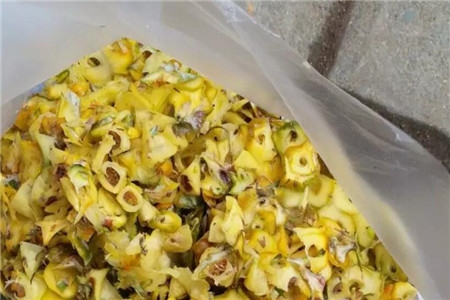
有的花友需要自己削果皮,可以参考下面这个方法哦
1、切头去尾
怕扎手的话可以带上手套~切掉菠萝的头和底端
切下来的菠萝头还可以水培呢
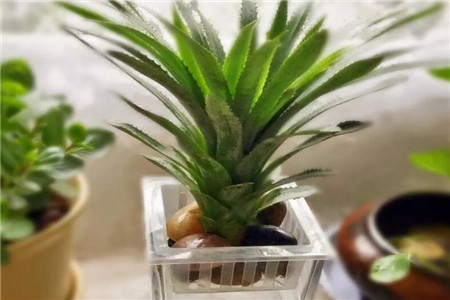
2、切掉菠萝皮
切掉3-5毫米的厚度就差不多啦,然后再横刀挖掉洞洞
有专门用来挖洞的小刀就更方便咯
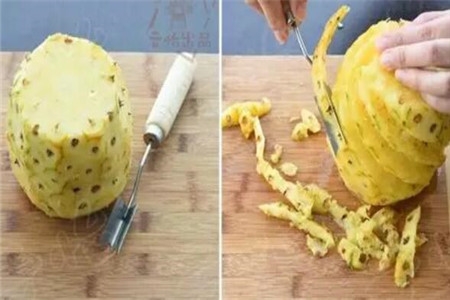
直接做清洁
新鲜的菠萝皮可以直接拿来清洗厨房污垢
掺点洗洁精一起擦锅底,菠萝是酸性的可以除铁锈,擦完又光又亮了!
菠萝皮放在新家里,还能除甲醛呢,正在装修的花友赶紧攒起来~
除此之外,菠萝皮的更大用处是:做酵素
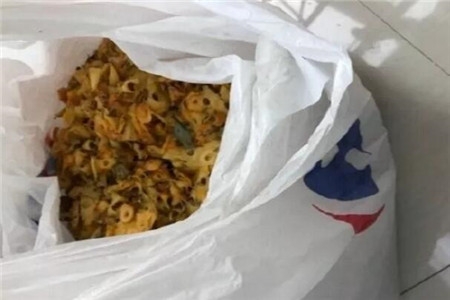
制作菠萝皮酵素
花友们肯定烦恼家里沤肥味道太大,花花推荐用菠萝皮来沤肥,不仅没异味,还香香甜甜的呢~咱现在就开始吧
1、菠萝皮洗净晾干
为了后面发酵的时候不变味变坏,先把菠萝皮洗一下
放在筛子上晾干
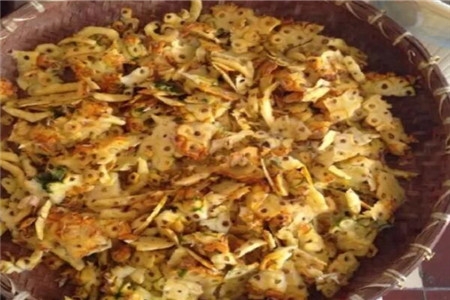
2、准备好容器、红糖
矿泉水瓶、玻璃瓶都可以,大家可以根据自家需要选择大小,提前把瓶子洗干净
瓶子晾干,里面不要有生水哈
准备好红糖,红糖和菠萝皮的分量比是1:3

3、在容器里加入红糖水(红糖和水的配比是1:10)
注意不要太满,大概装到容器的六分之一就行
4、加入菠萝皮
5、盖上盖子
6、每月要开盖放气
一般3个月才能腐熟,期间的发酵会产生一些气体,所以要注意放气喔
嫌麻烦的可以把橡胶手套扎在瓶口,气体多了就把手套“吹饱”,这时候就赶紧打开敞气儿~

一般每月打开1-2次就行,下面是第一个月开盖,酸酸甜甜的果香味儿,有一些浮沫是正常哒O(∩_∩)O
有些花友会发现酵素表面有一层白膜,这也是正常的,不是坏了喔
7、过滤待用
3个月后,酵素就发好啦,咱用纱布做滤网过滤一下
过滤之后装进小瓶
8、兑水浇花
菠萝皮酵素不能直接浇花,要兑清水才行(酵素:水=1:1000),不用经常浇,一个月浇两次就行,保证你的花越开越大,叶子绿油油!
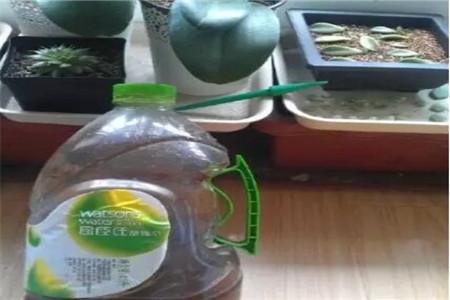
9、用作清洗剂
菠萝皮加洗洁精加水(1:1:10)可以做成强力清洗剂,清洁力强还带天然水果香呢
可以清理厨房水槽、台面等油腻污垢
用来拖地板,擦洗真皮沙发、玻璃桌面都是清爽又干净

卫生间的瓷砖、水台等也可以用它来清洗
其他水果皮通用吗
除了菠萝皮,苹果皮、柚子皮、桔子皮、橙子皮都可以做哒
下图左边是苹果酵素,右边是桔子皮酵素
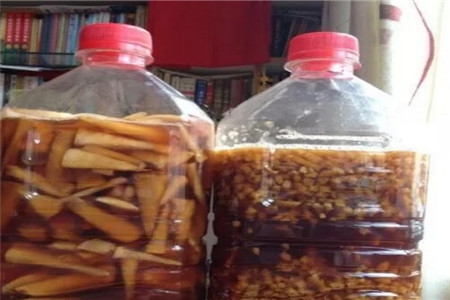
酵素一股果香,真是让人馋馋的~可以用果肉来做酵素,还食用呢!
下图为用菠萝肉、柠檬、冰糖做水果酵素

下图为菠萝、木瓜、猕猴桃、柠檬、红糖做水果酵素

做好之后过滤,装进瓶子美美哒,天然的果汁酵素喔~
可以当茶泡着喝
可以加进白水、酸奶、奶昔里,水果味的更美味!

说了这么多,大家有没有学会呢,下次吃菠萝的时候,赶紧试一试吧~
我们一般直接买削好的菠萝,毕竟咱可没有水果店老板的刀工啊
没关系,跟老板说把菠萝皮一起打包带走就行啦

有的花友需要自己削果皮,可以参考下面这个方法哦
1、切头去尾
怕扎手的话可以带上手套~切掉菠萝的头和底端
切下来的菠萝头还可以水培呢

2、切掉菠萝皮
切掉3-5毫米的厚度就差不多啦,然后再横刀挖掉洞洞
有专门用来挖洞的小刀就更方便咯

直接做清洁
新鲜的菠萝皮可以直接拿来清洗厨房污垢
掺点洗洁精一起擦锅底,菠萝是酸性的可以除铁锈,擦完又光又亮了!
菠萝皮放在新家里,还能除甲醛呢,正在装修的花友赶紧攒起来~
除此之外,菠萝皮的更大用处是:做酵素

制作菠萝皮酵素
花友们肯定烦恼家里沤肥味道太大,花花推荐用菠萝皮来沤肥,不仅没异味,还香香甜甜的呢~咱现在就开始吧
1、菠萝皮洗净晾干
为了后面发酵的时候不变味变坏,先把菠萝皮洗一下
放在筛子上晾干

2、准备好容器、红糖
矿泉水瓶、玻璃瓶都可以,大家可以根据自家需要选择大小,提前把瓶子洗干净
瓶子晾干,里面不要有生水哈
准备好红糖,红糖和菠萝皮的分量比是1:3

3、在容器里加入红糖水(红糖和水的配比是1:10)
注意不要太满,大概装到容器的六分之一就行
4、加入菠萝皮
5、盖上盖子
6、每月要开盖放气
一般3个月才能腐熟,期间的发酵会产生一些气体,所以要注意放气喔
嫌麻烦的可以把橡胶手套扎在瓶口,气体多了就把手套“吹饱”,这时候就赶紧打开敞气儿~

一般每月打开1-2次就行,下面是第一个月开盖,酸酸甜甜的果香味儿,有一些浮沫是正常哒O(∩_∩)O
有些花友会发现酵素表面有一层白膜,这也是正常的,不是坏了喔
7、过滤待用
3个月后,酵素就发好啦,咱用纱布做滤网过滤一下
过滤之后装进小瓶
8、兑水浇花
菠萝皮酵素不能直接浇花,要兑清水才行(酵素:水=1:1000),不用经常浇,一个月浇两次就行,保证你的花越开越大,叶子绿油油!

9、用作清洗剂
菠萝皮加洗洁精加水(1:1:10)可以做成强力清洗剂,清洁力强还带天然水果香呢
可以清理厨房水槽、台面等油腻污垢
用来拖地板,擦洗真皮沙发、玻璃桌面都是清爽又干净

卫生间的瓷砖、水台等也可以用它来清洗
其他水果皮通用吗
除了菠萝皮,苹果皮、柚子皮、桔子皮、橙子皮都可以做哒
下图左边是苹果酵素,右边是桔子皮酵素

酵素一股果香,真是让人馋馋的~可以用果肉来做酵素,还食用呢!
下图为用菠萝肉、柠檬、冰糖做水果酵素

下图为菠萝、木瓜、猕猴桃、柠檬、红糖做水果酵素

做好之后过滤,装进瓶子美美哒,天然的果汁酵素喔~
可以当茶泡着喝
可以加进白水、酸奶、奶昔里,水果味的更美味!

说了这么多,大家有没有学会呢,下次吃菠萝的时候,赶紧试一试吧~
0
1








